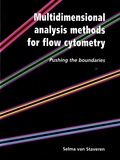Multidimensional analysis methods for flow cytometry
Pushing the boundaries

Staveren, Selma van
- Promoter:
- Prof.dr. L. (Leo) Koenderman
- Co-promoter:
- Dr. N. (Nienke) Vrisekoop
- Research group:
- Koenderman
- Date:
- May 21, 2019
- Time:
- 14:30 h
Summary
This thesis consists of two distinct parts. Firstly, we used flow cytometry and developed new methods to analyse flow cytometry data. Flow cytometry is a technique to measure characteristics of cells and thereby enabling the identification of cell types. Using flow cytometry the characteristics of healthy control cells can be compared to patient cells. The technique is often used for research as well as clinical diagnostic purposes. Over the past decade, analysing flow cytometry data has become more complex as an increasing number of parameters per cell can be measured, leading to big datasets. This has led to the necessity of multidimensional analysis methods for flow cytometry to allow deep phenotyping of cells. We have developed such a method, ECLIPSE, which automatically identifies disease specific cells. The most commonly used multidimensional analysis methods like SPADE, viSNE and flowSOM are not very suitable to identify disease-specific rare cells, as rare cells are overshadowed by the more abundant normal cell populations in the dataset. A unique feature of the ECLIPSE algorithm is the automated removal of normal cells from the dataset, leaving only disease-specific cells, making ECLIPSE very well suited for the identification and characterization of rare cell subsets. The power of ECLIPSE was illustrated by automated identification of minimal residual disease (MRD) in bone marrow samples from multiple myeloma patients undergoing treatment. The presence of MRD is correlated to worse clinical outcome. Therefore, early identification of MRD is important. ECLIPSE was able to identify the same number or even more malignant cells when compared to conventional flow cytometry analysis. In conclusion, ECLIPSE may be a promising technique for implementation in clinical diagnostics. Although new multidimensional analysis methods are emerging, still lot of challenges remain. For instance, pre-processing of flow cytometry data prior to multidimensional analysis has a great impact on the results and should be conducted with great care. We have developed a method for optimal transformation of flow cytometry data (called OTflow) prior to multidimensional analysis. This is important, as incorrect transformation may cause artifacts in the results and thereby misleading immunological conclusions might be drawn. In conclusion, multidimensional flow cytometry analysis methods are a necessity to retrieve all information from flow cytometry datasets. It is important for biological researchers and statisticians to collaborate and to develop multidimensional analysis methods together. In the future, multidimensional analysis techniques might be used in various settings, both in research and in a clinical diagnostics setting. Secondly, we studied the effect of microplastics on human health. Large plastic debris in our oceans breaks down into tiny particles called microplastics. These plastics are taken up by (shell) fish. As we consume fish, the microplastics enter our body and can pass our intestine wall. Neutrophils might be the first cell to encounter microplastics in our body. In vitro we found that neutrophils phagocytose microplastics and as they do, the cells die by great numbers (50-95% of the total neutrophils). These results provide a strong basis for future studies about in vivo effects of microplastics.